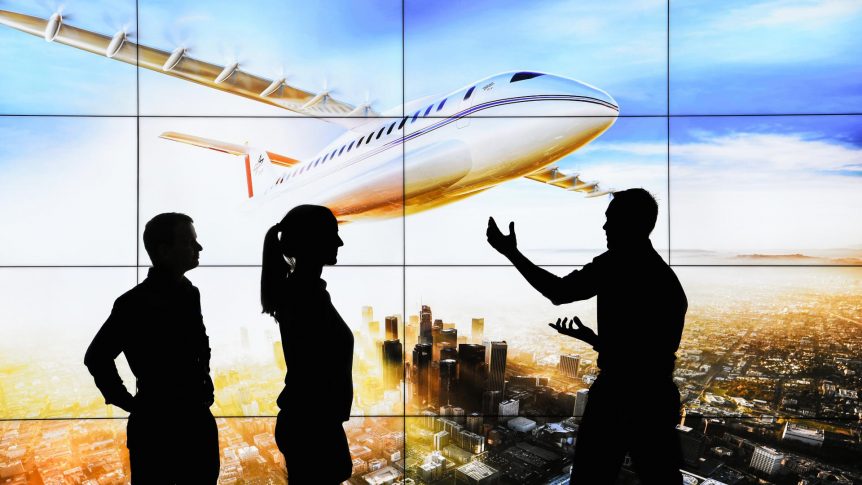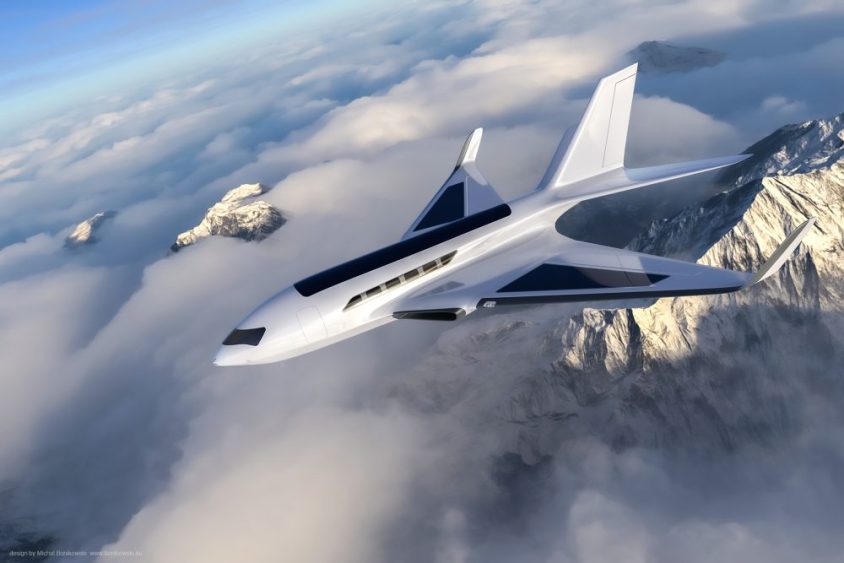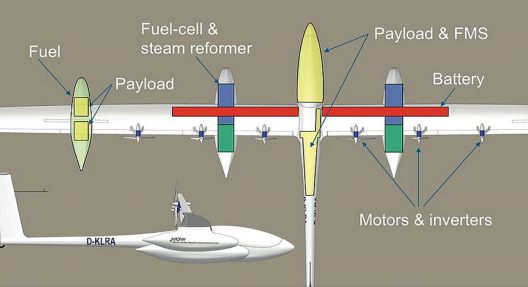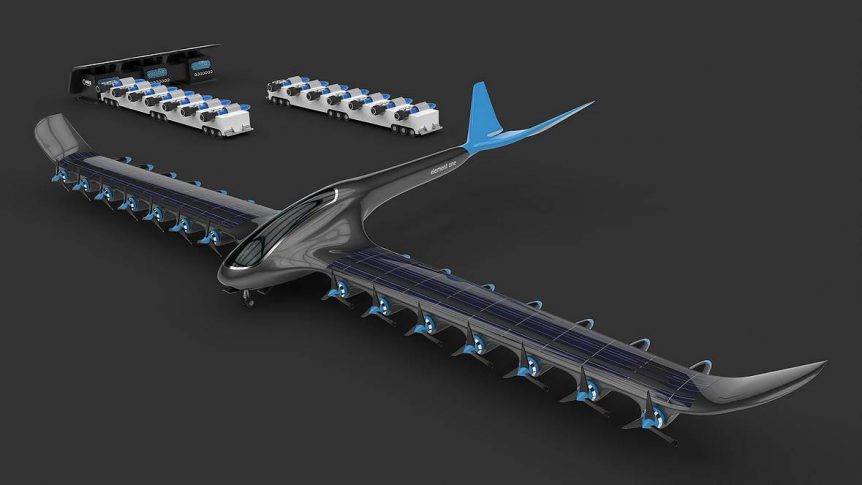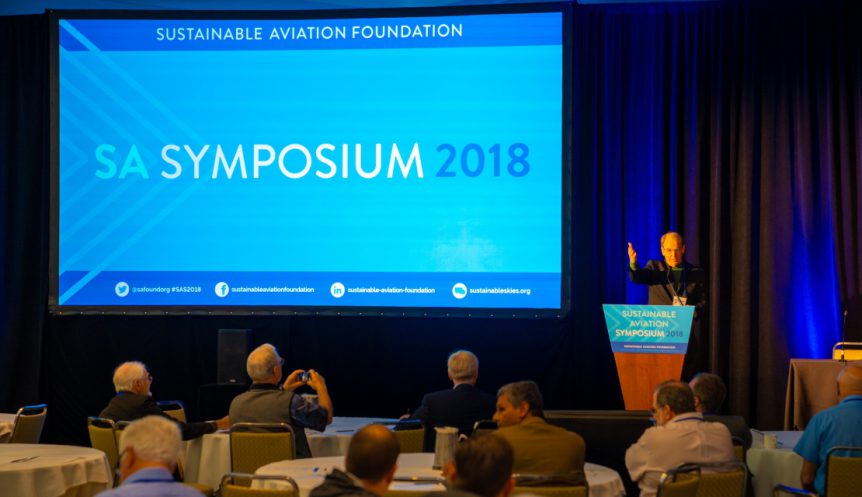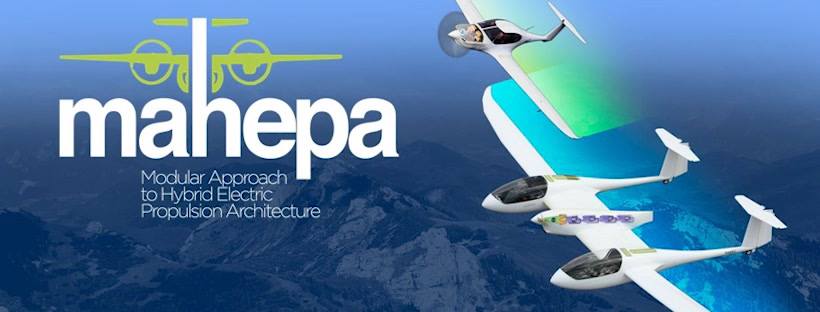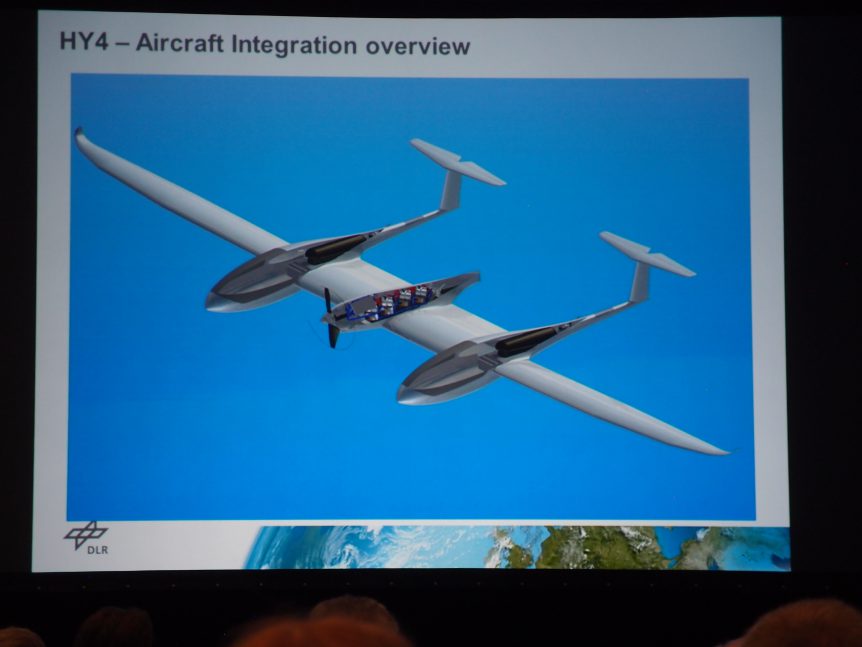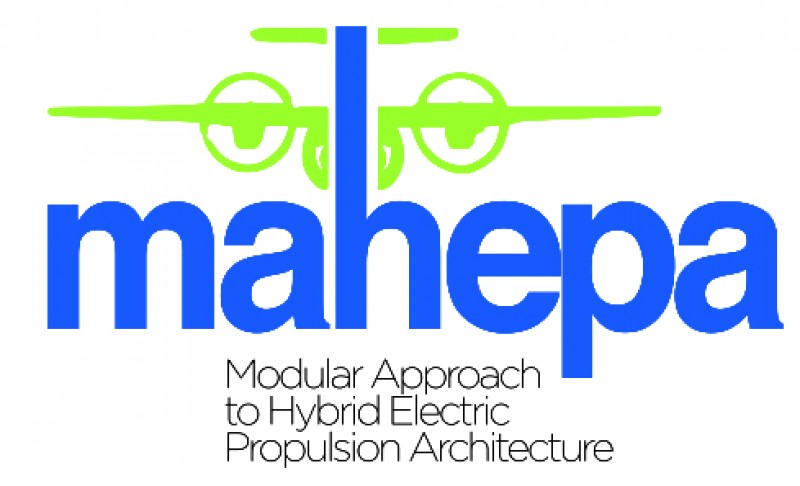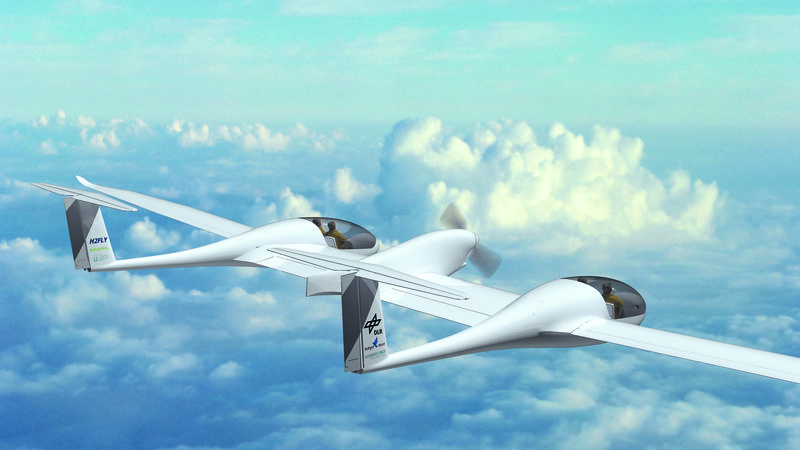One Size Does Not Fit All DLR (Deutsches Zentrum für Luft- und Raumfahrt or German Aerospace Center) and the German Aerospace Industries Association (Bundesverband der Deutschen Luft- und Raumfahrtindustrie; BDLI) present future visions of electric aircraft. These range from a four-seat hydrogen-powered repurposed Pipistrel that nine years ago won the NASA Green Flight Challenge to large, multiple propeller, medium-range airliners. Their White Paper, “Zero Emission Aviation – Emissionsfreies Fliegen” (unfortunately available only in German) promotes the promise of “energy transition in air transport, with the goal of zero emissions,” and claims this is “possible by mid-century but requires a considerable increase in innovation.” Rolf Henke, the member of the DLR Executive Board responsible for aeronautics research and technology, explains, “The time has come to start a new chapter in aviation. Our white paper shows the path to emission-free flying for the ‘Green Deal’ in aviation, which will lead to new technologies, attractive high-tech jobs, fascinating products and the promotion of …
Flying the Atlantic Electrically – The Freedom Flight Prize
It almost stops your editor in his tracks when he reflects that 93 years ago, Charles Lindbergh crossed the Atlantic in his Spirit of St. Louis. Even more astounding, competitors may win the Freedom Flight Prize by the 100th anniversary of that flight by making a cross-Atlantic and return flight in a 100-passenger, all-electric airliner. Carbon Footprint Ltd. Lindbergh’s plane, custom built but derived from a Ryan M-1 mail plane, cost $10,580 ($158,357 in 2019 dollars) and earned the $25,000 Orteig Prize. Now, an organization in England, “Carbon Footprint Ltd. has launched a competition to encourage sustainable passenger flight. It has created the Freedom Flight Prize, a competition focused on crossing the Atlantic Ocean 100-percent powered by renewable energy — with seating for 100. The first to do so will win the prize, which is expected to be worth millions of British pounds by the time there’s a winner,” according to Cleantechnica.com. “The competition is open to manufacturers, research/academic groups and inventors to …
Pipistrel’s Plans Evolve in Exciting Ways
In its 30th year, Pipistrel is making many changes, from a crisp new logo to new emphases and technologies. Its 801, intended for Uber’s Urban Air Mobility program, will segue into a cargo version and return later after the firm gains experience with deliveries. Meanwhile, Pipistrel will concentrate on developing a 19-seat, 300-mile range regional airliner while growing its global outreach for personal aircraft. Pipistrel is evolving and flourishing in exciting new ways. From Hang Gliders to Global Reach Ivo Boscarol, founder, owner and president of Pipistrel companies, CEO of Pipistrel d.o.o. Shares a look at his firm’s three-decade history and plans for the near future. Pipistrel reports in its newsletter, “The information that Pipistrel is running a program developing a large cargo-delivery hybrid-electric UAV in-house is accurate. For this program, we will be communicating about progress on a separate occasion, when we are ready to unveil the exact specifications, purpose and capability.” It will at the same time hold …
UMass Lowell Puts Hydrogen in a Canister
One problem with recharging electric vehicles is finding a charging station on the road. Electric vehicle makers provide GPS clues on their moving map displays, and electric pilots will doubtless have markers for fields with appropriate facilities for our future E-flyers. Researchers at the University of Massachusetts at Lowell may have done an end run around that problem, though. Their “new technology uses water, carbon dioxide and the metal cobalt to produce hydrogen gas on demand at a relatively low temperature and pressure.” The hydrogen produced goes directly to a fuel cell which generates electricity and powers the EV’s motor, rechargeable battery and headlights. When the canister that contains the H2 is empty, the driver can swap it with a “full” one. The researchers haven’t shared a great number of details, but we can guess the volume and weight of the canisters based on similar applications on the Pipistrel H4 and e-Genius, the much tested first and second-place winners, respectively, …
HES Element One Could Fly Four 5,000 Kilometers
Horizon Energy Systems (HES), originally based in Singapore, has pursued lightweight hydrogen propulsion systems for the last 12 years, primarily for amall drones. Going larger, the company announced plans today for Element One, “the world’s first regional hydrogen-electric passenger aircraft.” A four-passenger, 14-motored (!) monoplane, Element One will carry the lucky foursome 500 to 5,000 kilometers (310 to 3,100 statute miles). This distributed power system claims “virtually no change to its current drone-scale systems,” which is a little puzzling, considering the largest of such systems produces no more than 1,000 Watts. The scale of the Element One and its power packs is ambiguous, with illustrations showing a nine-axle trailer with attached solar panels ostensibly powering the on-site production of H2. One illustration depicts a drone-launching site with fuel pods possibly approximating the size of the units that will be used on Element One. These are larger and their scale relative to the people in the illustration gives an approximation of …
Sustainable Aviation Symposium – Free on YouTube!
The 2018 Sustainable Aviation Symposium was a master class in aircraft design, electric and hybrid power, and the strategies that will make green flight a reality in our near and distant futures. The considerable knowledge imparted in that gathering is now available for your education and enlightenment on YouTube. Better than (Most) Cat Videos Go here to see the entire 2018 Symposium program, complete with links to a video of each speaker’s talk. Or go here for the library of presentations on YouTube. Either link provides high-quality video of the 20 presentations from this year’s Sustainable Aviation Symposium. You will see all the slides in each presentation and hear each presenter’s eloquent exposition. These range from the simplest of garage-based projects (your editor’s attempt to build the world’s cheapest electric airplane) to far-ranging inquiries into the real-world blessings and possible consequences of having an aerial armada of commuter vehicles hovering over our cities. Like potato chips or peanuts, you probably …
Pipistrel leads MAHEPA – European hybrid research
Aviation Week’s Graham Warwick reports, “Europe plans to develop and test modular hybrid-electric propulsion technology using light aircraft as testbeds, but it is also studying whether the system can be scaled up to power 19- and 70-seat commercial aircraft. The MAHEPA Program intends to bring cleaner skies to Europe. Pipistrel, the Slovenian winner of NASA’s Green Flight Challenge in 2011, leads the 9 million euro ($10.4 million) program. Modular Hybrid Electric Propulsion Architecture (MAHEPA), funded as part of the European Union’s Horizon 2020 research program, will use real flight data to recommend how to reduce aviation carbon emissions 70-percent by 2050. Pipistrel will supply two well-tested aircraft for HAHEPA’s continued investigation of lowering emissions and expanding performance capabilities. First, its Hypstair hybrid four-seater is already at a technology readiness level (TRL) of 4, and MAHEPA will raise that to 6, ready to enter product development. Second, its eight-year-old G4, the battery-powered winner of the Green Flight Challenge and now converted …
Sustainable Skies in San Francisco
I’m writing this in the first person, rather than the usual third-person voice that allows me to remain objective about things on which I report. In this case, I have been the recipient of much joy over the last ten years from being an observer of the ongoing progress in electric aviation. Dr. Brien Seeley, founder of the Sustainable Aviation Foundation, asked me to begin writing a blog about electric aviation in 2009. One of my original postings concerned a Kitplanes Magazine contributor, David Ullman – who was this year’s Sustainable Aviation Symposium’s keynote speaker. In 2009, he predicted a great future for electric aviation – most of which has come to pass, and some of which he is creating in his hangar with his fully-instrumented wind tunnel and ambitious blown-wing design. He proposes something called USTOL, Ultimate Short Takeoff and Landing, aircraft that will use a dynamic relationship between their power and lift systems. His vehicle for demonstrating this …
MAHEPA, Modularizing the Approach to Clean Flight
Pipistrel, itself flying pure electric and hybrid aircraft, has announced its participation in MAHEPA, a Modular Approach to Hybrid-Electric Propulsion Architecture. MAHEPA aims to,” reduce the gap between research and the production of low-emission propulsion technologies that would enable the achievement of environmental objectives in the field of aviation by 2050.” Mahepa’s first meeting, held May 15 and 16 at Pipistrel’s headquarters at Ajdovscina (Slovenia), helped define the direction for a major academic/industry project. Led by the aircraft manufacturer, in cooperation with Compact Dynamics, DLR (Germany’s equivalent of NASA), the University of Ulm, H2Fly, Politecnico di Milano, TU Delft and University of Maribor, project goals are impressive. – “To boost research in the field of low emission propulsion technology to open up possibilities for series production of greener airplanes in order to support European environmental goals in aviation.” This will result in “novel, modular and scalable hybrid-electric powertrains capable of running on alternative fuels or on hydrogen with zero emissions.” …
SA Symposium 2017 – An April Festival of Electric Flight
April 21 and 22, 2017, set your GPS for N 37° 31′ 20.84” W 122° 15′ 38.31” – the Hotel Pullman San Francisco Bay. The refined and beautiful setting and four-star accommodations make a grand accompaniment to the story we will share. The story of the 2017 Sustainable Aviation Symposium includes the latest in aerodynamics, electric power and energy storage. It’s a grand and sweeping review, told by talented intellects in the context of using the latest technology to help save the planet. A few exemplars of the program highlight this year’s story, “ A Keynote Address from a Master Designer Tine Tomazic, Director of Research and Development for Pipistrel, created the G4 to win the 2011 Green Flight Challenge, the Alpha Electro Trainer, and the Hypstair hybrid speedster. His pioneering forays into electric power have made him a leader in development of everything from airframes to instrumentation. What will he come up with next? He might share that at …

